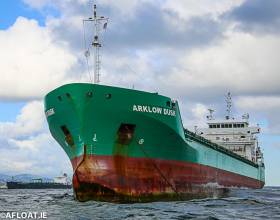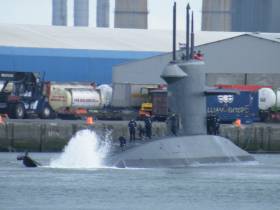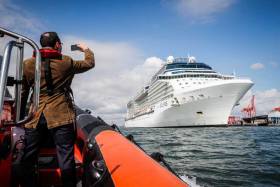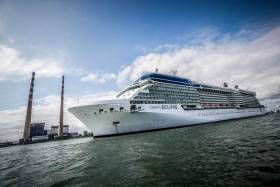Displaying items by tag: Dublin Port
#dublinbay- It was a busy scene in Dublin Bay during the May Bank Holiday as up to seven ships were at anchorage among them an Irish flagged cargo which stood out with its distinctive green painted hull, writes Jehan Ashmore.
The ship Arklow Dusk is the fourth and final of a quartet of 11,000dwt sisters acquired last year by Arklow Shipping following the bankruptcy of the Dutch based Flinter Group in 2016. The remaining sisters include Arklow Dawn, Dale and Day.
Acquisition of the former Flinter America and fleetmates as secondhand tonnage is unusual for ASL as the Co. Wicklow based company notably in recent years have taken delivery of newbuilds of various designs from Dutch and German shipyards.
Arklow Dusk had previously docked in Dublin Port after a voyage from Bilbao, Spain. On board was a cargo of cement products that were discharged alongside Ocean Pier. This was the first time the 132m double-hold cargoship made a call to the capital.
On completion of unloading, Arklow Dusk proceeded 'light' to Dublin Bay to anchor in the early hours of Thursday night. On the Bank Holiday Monday, the arrival of cruiseship Norwegian Pearl stood out and as the inaugural caller of the season to Dun Laoghaire Harbour.
The presence of these seven ships on Monday was short lived as by mid-morning Arklow Dusk having awaited orders departed. The 'D' class ship was bound again for Spain but this time to Carino located in north-west of the Iberian nation.
As Arklow Dusk set a southbound course along in the opposite direction came Schelde Highway from Zeebrugge, Belgium. The vehicle-carrier headed into the bay to occupy the same area where the Arklow-registered cargoship had taken up anchorage for more than four days.
Direct Shipping Routes to Europe on the Agenda as Flemish Government Visits Dublin Port
Delegates from the Flemish government visited Dublin Port Company to discuss the importance of direct shipping routes to Europe and preparations in the lead-up to Brexit.
Such preparations include the launch of the world’s largest roll on-roll off ship Celine and her sister ship MV Laureline who made her maiden voyage from Dublin Port last March.
#navalvisitors - One of the world's most sophisticated submarines and an accompanying support ship of the Royal Netherlands Navy arrived in Dublin Port yesterday for a three day crew rest and recreation visit, writes Jehan Ashmore.
This is not the first Dutch Navy visitor to the capital this year as HNLMS Van Speijk, a Karel Doorman-class frigate was part of a three EU member state flotilla that called last month.
On this current visit, the first to arrive in Dublin Bay was submarine HNLMS Zeeleeuw, which has a 2,650 tonnes displacement (when submerged). In advance of entering the port a tug along with a small craft assisted the diesel-electric powered submarine while off the South Burford Bouy.
HNLMS Zeeleeuw was commissioned in 1990 however the submarine unintentionally became the first of the 'Walrus' class as HNLMS Walrus was delayed for a long period following a serious fire during construction. The 68m submarine was built by Rotterdamsche Droogdok Maatschappij.
The Walrus class instead of using a cross-shaped assembly of stern diving planes and rudders, they mount four combined rudders and diving planes in an "X" tail configuration (as more clearly demonstated in related story photo).
In total there are four submarines in the class and the quartet play a pivotal role in operations given these submarines have stealth designed technology. Deployments include overseas patrols in the Caribbean Sea with calls to Williamstad, the capital of the Netherlands Antilles.
The second visitor to Dublin is HNLMS Mercuur, which is the only surface vessel designed specifically to support the operations of the Dutch Navy. The 64m vessel was built by Damen Schelde Naval Shipbuilding and entered service in 1987.
Both naval visitors are berthed downriver in the main part of the port having been allocated berths at Ocean Pier within Alexandra Basin. They will not be open to public tours.
The pair are scheduled to depart on Friday with an hour appart of each other exiting the port in the morning.
Cruise Passengers Numbers: Irish & UK Hits Record Two Million
#cruiseliners - Cruise passenger numbers from Ireland and the UK hit a record two million last year, figures from the Cruise Lines International Association show.
As the Irish Times reports the association bundles together Irish and UK numbers as most of the cruise itineraries take in both islands.
The Irish Travel Agents Association (ITAA) welcomed the record-breaking numbers, noting they signalled a 2 per cent year-on year-growth in passenger numbers.
“The cruise industry is demonstrating considerable growth, and has become an important part of both inbound and outbound Irish tourism,” said ITAA chief executive Pat Dawson.
“By hosting turnarounds Irish ports allow tourists to end their sailing here and travel within Ireland before flying directly home, while Irish holidaymakers join the ship to set sail on their adventure.”
Nonetheless Mr Dawson said it is disappointing that Dublin Port was reducing the number of cruise liners it will host.
Last year saw 150 ships call to Dublin Port and we expect this to rise to over 160 by the end of 2019.
For further reading on this story, click here to the newspaper.
Meeting with Minister Ross & Cruise Ireland Seen as 'Positive Step' for Irish Cruise Industry
Chairman of Irish Cruise Liner body Cruise Ireland, Mr Conor Mowlds said; “Cruise Ireland welcomed the positive meeting held with Shane Ross TD, Minister for Transport, Tourism and Sport, Brendan Griffin TD, Minister of State with responsibility for Tourism and Sport, government agencies and other commercial bodies involved in supporting Ireland’s Cruise Industry.
The meeting was called by Ministers Ross to discuss Dublin Port’s temporary move to reduce cruise vessel calls to the capital while it develops additional essential port infrastructure during the interim period of 2021-2024.
The meeting provided an opportunity for the relevant bodies to consider the options available to Ireland that would help to reduce the impact on the Irish Cruise Industry following Dublin Port’s strategic decision.
With this meeting and the recent attendance at the Global Cruise Seatrade Exhibition in Miami, Cruise Ireland is confident that positive measures are being taken to mitigate the temporary impact on the industry, and we are committed to supporting the future marketing and promotion of Ireland as a premier cruise destination.”
#cruiseliners - RTE news reports of efforts to be made to reduce any effect fewer cruise ships entering Dublin Port from 2021 will have on Dublin, it's retailers and ancillary businesses.
That's according to a spokesperson from Department of Transport Tourism and Sport, following a meeting between Ministers Shane Ross and Brendan Griffin, the tourism agencies and port chiefs.
Representatives from Fáilte Ireland, Tourism Ireland, Tourism Northern Ireland, the Port of Cork, Dublin Port, Shannon Foynes, the Galway harbour company, the Port of Waterford company and the Port of Belfast were in attendance.
The meeting discussed options that could be pursued to minimise disruption for the cruise industry and what, if any, other options there might be for the cruise industry around Ireland.
The spokesperson said the general consensus expressed was that the impact on the industry as a whole, across the island, should be modest but the impact could be acute on certain businesses.
More on the story can be read here.
Navies from EU Member States On Visit to Dublin Port
#navalvisitors - Navies from three EU member states have become the first foreign naval visitors of the year to call to Dublin Port having taken up berths since mid-week, writes Jehan Ashmore.
Over the previous two days, French, British and Dutch navies in that order have arrived to the capital and which has led to berths occupied at Ocean Pier, the marina at the Poolbeg Y&BC and at the North Quay Wall Extension. Next to the pier's Extension is the Tom Clarke (East-Link) bridge from where it should be possible to view all five visiting vessels.
As these naval vessels have occuppied berths within the more secure corden of the port's main estate located beyond the East-Link, they will not be open to public visits. Subsequent naval visitors, however may instead arrive to berth upriver along the Liffey Quays and hold public tours (or not as the case can be). Along this river bank is Sir John Rogersons Quay where such tours have been held and is convenient for the public to access given the close proximity of the capital's centre.
On this current call of naval visitors, the berth at Ocean Pier is where the French Navy's high-sea patrol vessel Premier maître l'Her is docked. The corvette is of the Estienne d'Orves class. Among its armoury is a SIMBAD anti-aircraft missile system. A sister Lieutenant de vaisseau Le Hénaff visited the port in 2017 but on that occasion headed upriver to berth along Sir John Rogersons Quay as pictured above.
Opposite of Ocean Pier on the south bank of the Liffey is the Poolbeg Marina, where the UK's Royal Navy presence consists of a trio of P2000 Archer class fast inshore patrol boats. The leadship of the class HMS Archer is joined by HMS Example and HMS Explorer.
These small craft provide training and maritime experience for University Royal Naval Unit students. In addition the URNU also provide support to wider Fleet tasking and exercises around the UK and Europe waters.
As for the waters of Dublin Port, the Royal Nederlands Navy is represented on this visit by HNLMS Van Speijk. This is the last ship of eight Karel Doorman-class multi-purpose frigates serving the Dutch navy and which was commissioned in 1995. Likewise of the French visitor, this frigate includes missiles in the form of the Sea Sparrow system.
Dublin Port Company (DPC) has today announced an initiative to decrease the dwell time of containers and trailers at Dublin Port so as to increase the Port’s throughput capacity for future growth.
As Afloat reported earlier, Phase 1 of the Dublin Port Dwell Time Initiative* will see DPC reduce the free time period allowed for containers and trailers (from seven days to four days) at one of the three container terminals in Dublin Port which handles trade with Continental Europe. DPC will also double the daily quay charges applied after this free period (from €20 per day to €40 per day for a 40’ container).
The changes come into effect on 1st June 2019 and will apply to container and trailer traffic using the terminal operated by Doyle Shipping Group (DSG). The terminal is owned and controlled by Dublin Port Company.
Dwell Time refers to the amount of time an import container or trailer spends waiting to be picked up at a terminal after being unloaded from a ship (or the time an export container or trailer spends in a terminal before being loaded onto a ship). After the allowed free period, daily quay charges are applied until the container or trailer leaves the terminal.
DPC is introducing the measure in order to maximise the use of land at the terminal. Shorter dwell times will lead to fewer containers being stored for longer than necessary, thereby freeing up space for more cargo to move through the same amount of land. This increases port capacity.
Q1 2019 Trade Figures
The initiative comes as new trade figures for Q1 2019 reveal that Dublin Port experienced its busiest single month on record with throughput of 3.4m gross tonnes in March, with overall cargo volumes for the first quarter up by 7.0%. The first quarter growth to 9.7 million gross tonnes came from both rising imports (+8.0%) and increasing exports (+5.6%).
Brexit Impact
The terminal operated by DSG accounts for 45% of containers and trailers moving between Dublin and ports in Continental Europe and beyond. DPC is already seeing accelerating growth on direct routes to Continental Europe in advance of Brexit.
The need to maximise the use of land at Dublin Port is more pressing following the loss of eight hectares of port lands to State Agencies for secondary inspection facilities required after Brexit. Although eight hectares equates to only 3% of the overall land area at Dublin Port it represents 25% of the port lands available for development for the transit storage of freight in containers and trailers under Masterplan 2040.
Eamonn O’Reilly, Chief Executive, Dublin Port Company, said;
“Our container terminals are operating at half of the target land utilisation we set for them in our Franchise Policy in 2014. One of the impacts of Brexit is that we have to achieve these targets sooner. The Dublin Port Dwell Time Initiative provides essential financial incentives to move cargo through the port more quickly.
“I am calling on the operators of the two leased container terminals – ICG’s DFT Container Terminal and Peel Ports – to follow our example and become similarly ambitious in the efficient use of Dublin Port land.
“It is no longer acceptable for shipping lines and container terminals to compete with each other based on how inefficiently they use scarce port lands. We are focussing first on Dublin Port’s three container terminals and our objective is to reduce average dwell times in the three terminals to two days by the end of 2021.
“The changes we are introducing will require significant alterations in supply chains. With volumes growing rapidly and Dublin Port set to reach full capacity by 2040, the days of container terminals in Dublin Port providing free or very cheap storage for importers or exporters are coming to an end.
“With all the economic uncertainty, volumes through Dublin Port are remarkably robust and underpin the need for us to continue to invest in additional port infrastructure guided by our own Masterplan 2040 and by Project Ireland 2040. We are currently seeking Government approval for company borrowings of €300m to continue the Port’s ambitious and essential ten-year €1 billion investment programme.”
DublinTown, the not for profit organisation charged with creating a welcoming and economically viable city environment in Dublin, has urged Dublin Port to provide clarity in relation to its decision to severely restrict cruise ship tourism to Ireland. Dublin Port recently announced that it is to cut cruise ship calls to the city by more than 50%, from 172 in 2018 to 80 in 2021. Between March and October this year, the country will receive almost 300,000 passengers and crew and from cruise ships stopping in Dublin Port, before moving on to destinations like Cobh, Waterford and Belfast.
Richard Guiney, CEO of DublinTown, has made a number of requests of Dublin Port, stating: “DublinTown, on behalf of its members, would like to ask the port to make an unambiguous statement on its intentions in relation to cruise tourism.
“Cruise tourism has become an important element of trade for many city businesses. This ranges across independent retail, publicans and coach operators. Cruise tourists actively seek Irish craft and spend handsomely within the city. Based on feedback from both the port and cruise line companies, many were optimistic, that this trade was set to grow, particularly through home porting where the cruise both begins and ends in Dublin. Cruise lines have let it be known that without Dublin, Ireland becomes an unattractive destination with serious consequences for Cork, Waterford and Belfast. We have seen that Northern Ireland’s First Minister has raised the issue with Minister Shane Ross.
“In recent weeks we have heard mixed statements and intentions. There is a need for clarity. We would like Dublin Port to answer the following questions?
There will be 172 cruise ships visiting Dublin Port in 2019. We were told that there will be 80 in 2021. However, it would appear that many of these are smaller ships and that perhaps as little as 30-40 of the ships we have come to know will be accommodated in 2021. For clarity can the port advise how many passengers will visit in Dublin 2019 and how many will visit in 2021?
Through media reports we have been advised that the reductions are of a temporary nature and that there is an intention to return to 150 ships in 2023 and that this number would be grown thereafter. Can Dublin Port answer unambiguously if an agreement on these numbers has been agreed with the cruise lines? Can we have a categoric commitment from the port in relation to this stated intention?
How many cruise passengers and cruise ship crew does Dublin Port intend to welcome in 2023?
We understand that a decision was conveyed to the cruise lines that it was the port’s intention to cease home porting. Is this the case? If not, how many cruise ships will homeport in Dublin in 2023?
Why has Dublin Port withdrawn from Cruise Ireland and Cruise Europe, and why has it ceased attending cruise events and trade shows if the retrenchment is temporary? Given the need to maintain contacts and goodwill, is the port willing to reconsider its decision to withdraw from these groups and re-engage fully with the industry?
What steps does Dublin Port intend to take to repair the damage done to Ireland’s reputation as a tourist destination caused by how it has handled and communicated its decision?
“The communication of the port’s decision has, unfortunately, lent itself to rumour and a degree of concern. There is no doubt that there has been some anger and frustration amongst key stakeholders. Cruise tourism is an important matter for our members, and we believe that it is incumbent on Dublin Port to engage with openness and transparency with those whose livelihoods have been compromised by its decision.”
#cruiseliners - Independent.ie reports in a reduction in the number of cruise ships entering Dublin Port will cause considerable damage to the tourism sector on the island of Ireland, the leader of the DUP has warned.
It is understood that Arlene Foster has been in contact with transport minister Shane Ross to outline the impact that reduced cruises will have on both sides of the border. Foster fears that companies may now go elsewhere.
It follows news that the Dublin Port Company was considering curtailing its cruise business in order to make way for more freight after Brexit. Business groups have heavily lobbied against the port's decision insisting it could heavily damage businesses in the city.
More on the story here.


































































